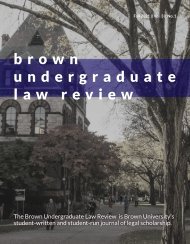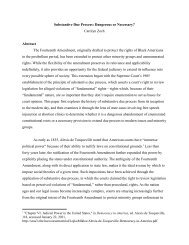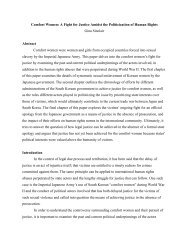Legal Realism and Eugenics: The Fallibility of Empirics
Christopher Morillo '21
Christopher Morillo '21
Create successful ePaper yourself
Turn your PDF publications into a flip-book with our unique Google optimized e-Paper software.
Legal Realism and Eugenics: The Fallibility of Empirics
Christopher Morillo
Abstract
In 1925, the state of Michigan sought to forcibly sterilize a young man on account of his
perceived “feeble-mindedness.” Despite his appeal, the Michigan Supreme Court declared the
state’s sterilization act to be constitutional in the case Smith v. Wayne Probate Judge (1925). This
paper examines the case as a window into the rise of legal realism. Specifically, this paper is
concerned with the use of empirical knowledge to justify new police powers at the expense of
individual rights. Drawing parallels to the earlier legal realist ruling in Muller v. Oregon (1908),
this paper also considers the fallibility of empirics in legal reasoning more broadly.
Several years before the U.S. Supreme Court infamously affirmed forced sterilization in
Buck v. Bell (1927), C.J. Willie Smith was ordered to be sterilized by a local judge due to his
“feeble-mindedness.” 1 A 1923 Michigan act had authorized such sterilizations on the basis of
recent scientific developments warning that “feeble-mindedness” was a hereditary condition. In
1925, despite Smith’s appeal, the Michigan Supreme Court ultimately refused to hold the
Michigan sterilization act unconstitutional, relying firmly on the language of legal realism. That
case, Smith v. Wayne Probate Judge (1925), is thus an excellent window into the rise of legal
realism and its role in justifying new police powers at the expense of individual rights. By
comparing Smith to the earlier Muller v. Oregon (1908), this paper will examine the ways in
which empirical knowledge was used to construct concerns of “public welfare”—in particular,
eugenicist ideas of racial fitness—that ultimately justified the broadening of state police power.
Long before the Smith ruling, legal realism had already taken hold as a competitive
ideology in American jurisprudence. In the preceding Lochner era, legal formalists conceived of
the law as “a system of logic and deductive reasoning,” but in the context of the progressive era,
new value was placed on induction and the role of empirics. 2 Further, developments in the
natural and social sciences inspired new solutions to societal questions. Advocates of legal
realism argued that the law, in attempting to resolve such questions, ought to pay attention to
1
Smith v. Wayne Probate Judge, 231 Mich. at 422.
2
Nancy Woloch, Muller v. Oregon: A Brief History with Documents (Boston: Bedford Books of
St. Martin's Press, 1996), 26.
empirical knowledge. Justice Oliver Wendell Holmes Jr.’s dissent in Lochner v. New York (1905)
is often credited with initiating an era of legal realism, but Holmes had articulated the idea as
early as 1881 in his lecture series, The Common Law, in which he stated, “The life of the law has
not been logic; it has been experience.” 3 The “Brandeis brief,” submitted to the U.S. Supreme
Court in the 1908 case Muller v. Oregon, is one of the more famous instances of this type of
jurisprudence and certainly follows Holmes’s maxim. In Muller, the court addressed an Oregon
statute that limited the working hours of women more so than those of men. Compiling a brief
filled with medical and sociological data and testimony, Louis D. Brandeis attempted to portray
“the world’s experience upon which the legislation limiting the hours of labor [was] based.” 4 The
brief was successful, conclusively influencing the court to uphold the statute in question, and its
emphasis on experience rather than formalist principles makes it a quintessential work of legal
realism.
The majority opinion in Smith reflects a continuation of the above legal realist tradition.
First, Smith’s focus on expert opinion and empirics is broadly evocative of the trademark tools of
the legal realist. The opinion contains a vast number of citations from medical and academic
professionals and it seems to prefer such citations to classical legal deductive logic. After
quoting Dr. A. F. Tredgold and Samuel J. Holmes and referring to a consensus of opinions of
“noted experts” at the English Royal Commission of 1904, the court is self-satisfied and
proclaims that it will not “extend this opinion by repeating the testimony of these eminent
biological and medical experts.” 5 Such language reflects the justices’ belief in the infallibility of
the empirics they had been presented, and as a result they are quite dismissive of the principled
questions of equal protection and substantive due process presented by the plaintiff. The court
decides that “science has demonstrated to a reasonable degree of certainty that
feeble-mindedness is hereditary” and thus it concludes that there is a public welfare concern that
justifies forced sterilization. 6
Second, the justices in Smith make an effort to consider and prioritize the will of the
legislature in regard to the relevant statute. Legal realists argued that “judges ought not, as a
matter of course, to use their power to interfere when the legislature, acting on sound evidence,
3
Oliver Wendell Holmes, The Common Law (Cambridge: Harvard University Press, 2009), 3.
4
Woloch, 112.
5
Smith v. Wayne Probate Judge, 231 Mich. at 414.
6
Ibid.
had decided to pursue a certain policy.” 7 The majority opinion in Smith reflects such increased
discretion allotted to the legislature, stating, “this question [of whether feeble-mindedness is a
sufficient public welfare concern] was for the legislature, and they have answered it in the
affirmative by the enactment of the statute.” 8 This allotted discretion is even more pronounced in
Justice Clark’s concurring opinion, in which he admits to possessing some doubts regarding the
scientific facts of the case but resolves that the judiciary ought to defer to the legislature.
Following the legal realist tradition, the justices in Smith seem to conceive of their role as
uncovering and gathering the facts and experiences upon which the legislature had acted.
Finally, it should be noted that while Smith upholds the constitutionality of the Michigan
sterilization act, it ultimately vacates the specific order to have Willie Smith sterilized. However,
even this decision is indicative of the court’s preoccupation with legal realism. The statutory
requirements embedded in the Michigan sterilization act demanded that at least three examining
doctors and experts appear at a court hearing before a sterilization was to be ordered. However,
Willie Smith’s examining doctors merely filed certificates approving sterilization. Thus, the
justices vacated the order for having failed to follow the statutory safeguards. Despite vacating
the specific order in question, the court’s emphasis on the in-person testimony of “three reputable
physicians” reflects their faith in scientific expertise in general and as a primary factor in legal
decision-making. 9
Smith and Muller are quintessential instances of legal realism in action. Comparing them
more directly, both cases use the legal realist framework to justify increased police powers out of
concern for “public welfare.” In Smith, in line with the legal realist tradition, the justices weigh
the social and economic ramifications of their decision, even against claims of rights violations.
The court asks, “Measured by its injurious effect upon society, what right has any citizen or class
of citizens to beget children with an inherited tendency to crime, feeble-mindedness, idiocy or
imbecility?” 10 Similarly, Muller concludes that “the physical well-being of woman becomes an
object of public interest and care in order to preserve the strength and vigor of the race.” 11 Both
opinions then use these premises to justify increased police powers. “Acting for the public
7
Kermit L. Hall and Peter Karsten, The Magic Mirror: Law in American History (New York:
Oxford University Press, 2009), 245.
8
Smith v. Wayne Probate Judge, 231 Mich. at 423.
9
Ibid.
10
Ibid.
11
Woloch, 148.
good,” the majority opinion in Smith declares, “the State, in the exercise of its police powers,
may always impose reasonable restrictions upon the natural and constitutional rights of its
citizens.” 12 For Willie Smith, this “restriction” is quite tangible with the act of sterilization. For
the women in Oregon affected by the Muller decision, the restriction is against their liberty to
form contracts, both in absolute terms and relative to the liberty retained by men. Despite
differences in the natures of these police powers, the cases are similar in their uses of legal realist
frameworks to justify those powers and to define what constitutes the “public welfare.”
It is not insignificant that both cases discuss the “public welfare” in terms of eugenicist
ideas and language, framing sterilization and even hours regulation as primarily questions of
racial fitness. Eugenicist language is present throughout Muller, for instance, with references to
“the strength and vigor of the race” as well as “the future well-being of the race.” 13 The opinion
emphasizes evolutionary and biological concepts and effectively reduces women to their
reproductive role. Likewise, in Smith, the sterilization act is justified on the premise that there
exists some duty to “protect the people and preserve the race.” 14 To an extent, the presence of
eugenicist ideas in these opinions is a product of the times in which they were written. In the first
decades of the 20th century, eugenics was an increasingly popular application of Darwin’s theory
of natural selection, with interventions proposed to ensure the “survival of the fittest” in terms of
intelligence, racial purity, physical attributes, and the like. However, that eugenicist ideas would
be able to influence legal opinions in this way is particularly significant. First, eugenicist ideas
themselves represent the ways in which empirical knowledge—about biology or hereditary traits,
for instance—can be drawn to questionable, if not horrific, implications. Second, that both
Muller and Smith, and later Buck v. Bell, would legitimize eugenicist policies and ideas while
operating under legal realist frameworks suggests the vulnerabilities of the legal ideology. 15
Legal realists, by incorporating empirical knowledge into legal decision-making to such an
extent, might find their reasoning biased by the dominant interpretations in the natural and social
sciences.
12
Smith v. Wayne Probate Judge, 231 Mich. at 415.
13
Woloch, 148–49.
14
Smith v. Wayne Probate Judge, 231 Mich. at 415.
15
In Buck v. Bell, the Supreme Court ruled that a compulsory sterilization statute did not violate
the Constitution. The decision was written by Justice Holmes and, in the tradition of legal
realism, emphasized the hereditary nature of “feeble-mindedness” as a public welfare concern.
The dissenting opinion in Smith is a refreshing and explicit critique of legal realism along
these lines. Justice Wiest condemns his fellow justices for their faith in “new scientific names
and theories . . . pressed with the zeal and intolerance of converts obsessed with the fallible
wisdom of questionable opinions.” 16 He questions the role of empirics in jurisprudence,
specifically when it involves subordinating “pity and mercy and humanitarianism . . . to
utilitarian considerations.” 17 Ultimately, the contrast between the dissenting opinion and majority
opinion in Smith reflects the broader division in legal ideology at this particular historical
moment. Following the formalist tradition, Wiest refers to legal principles, precedent, and the
“inherent rights of mankind” to deduce that police powers cannot violate bodily integrity to the
extent of sterilization. In this sense, Wiest’s opinion is similar to the brief submitted on behalf of
Muller in opposition to the Brandeis brief. Muller’s brief is similarly rooted in notions of rights
and in the theoretical nature of the legislation in question, with frequent references to precedent
rather than empirics. Read together, the conflicting language between these sources reflects the
broader intellectual divide of the era. At the core of this divide is the question of the worth of
empirical knowledge and its place in the courtroom and in legal decision-making. And though
we have long since passed the heyday of legal realism, that simple question has loomed over
courtrooms ever since.
Smith reflects the premium placed on empirical knowledge during the era of legal realism
and illustrates some of the tradition’s potential drawbacks, giving credence to intellectuals like
Michel Foucault who were particularly interested in questioning the assumption that the sciences
are a neutral discipline. Foucault suggested that scientific knowledge is a product of historical
processes and power relations, emphasizing the discipline’s role in constructing institutions of
social control like gender or “feeble-mindedness,” to which Muller and Smith also lend credence,
respectively. But one need not be a Foucauldian to admit that there is fallibility in empirics.
While this fallibility is certainly not unique to legal realism, there is something to be said about
the ways in which we are particularly vulnerable to taking the neutrality of empirical knowledge
and expertise for granted.
16
Ibid.
17
Ibid.










